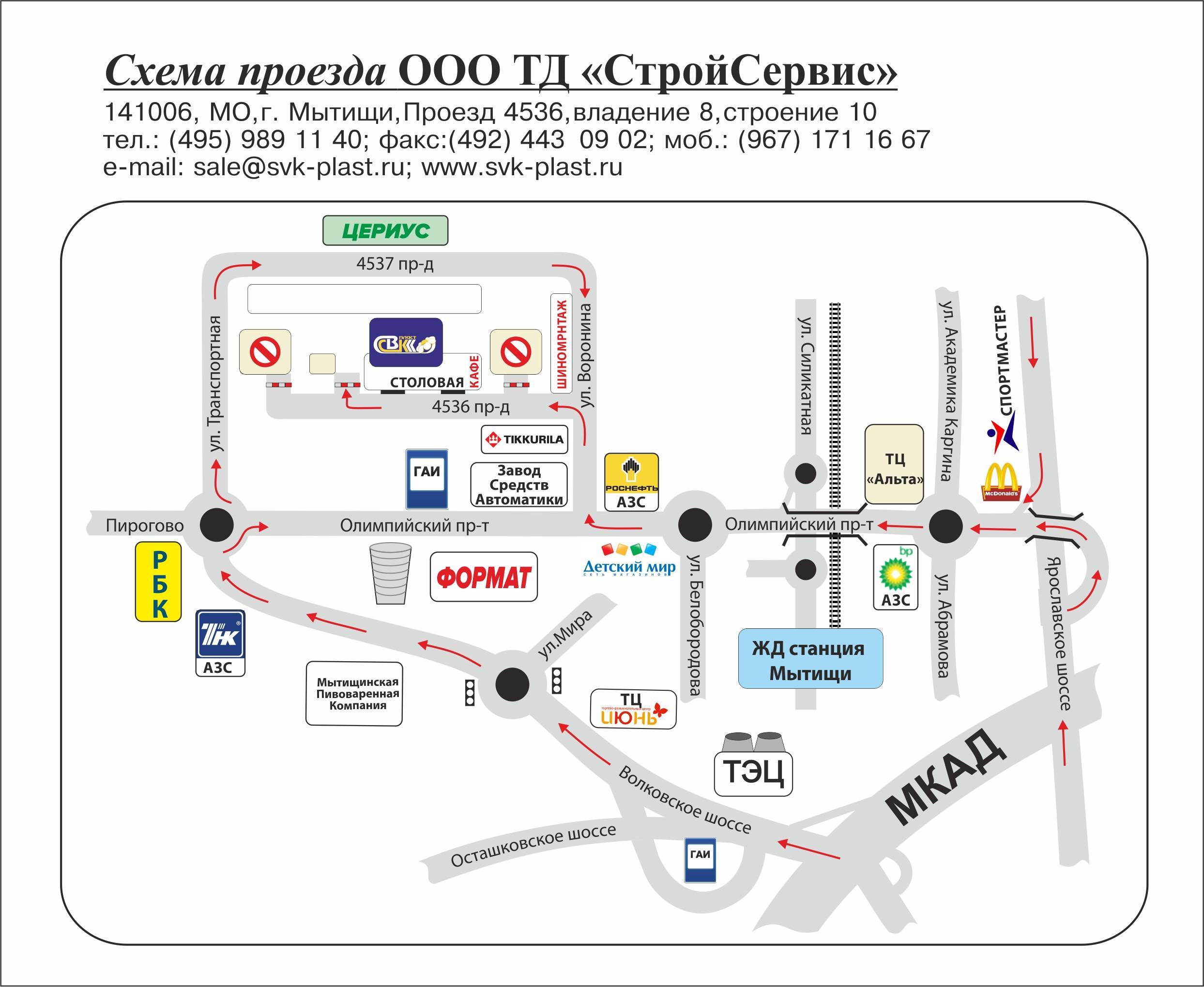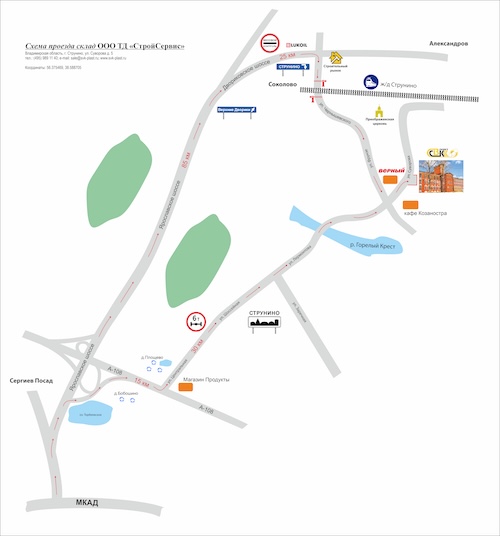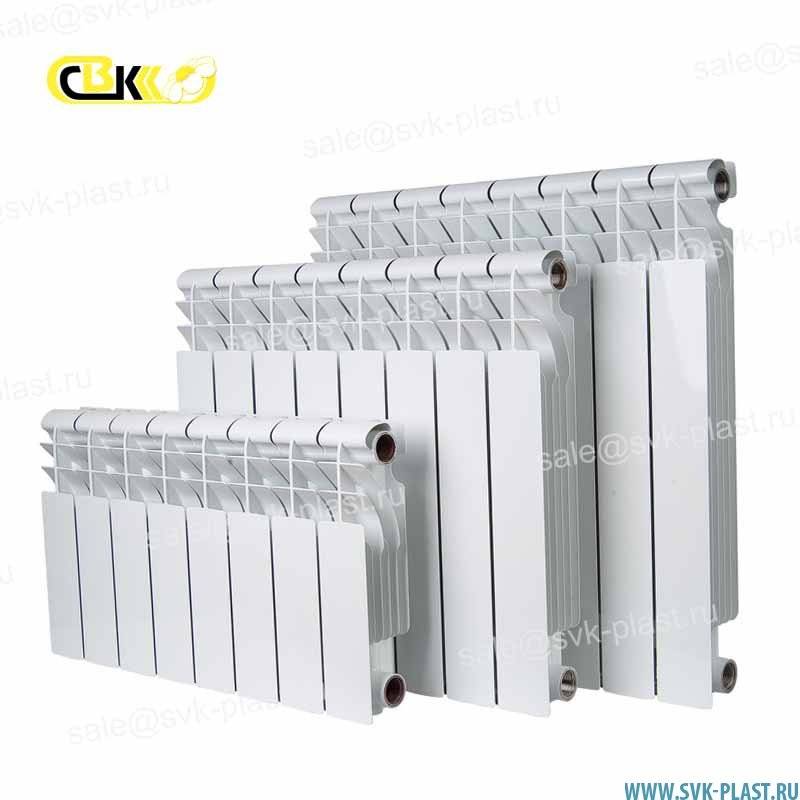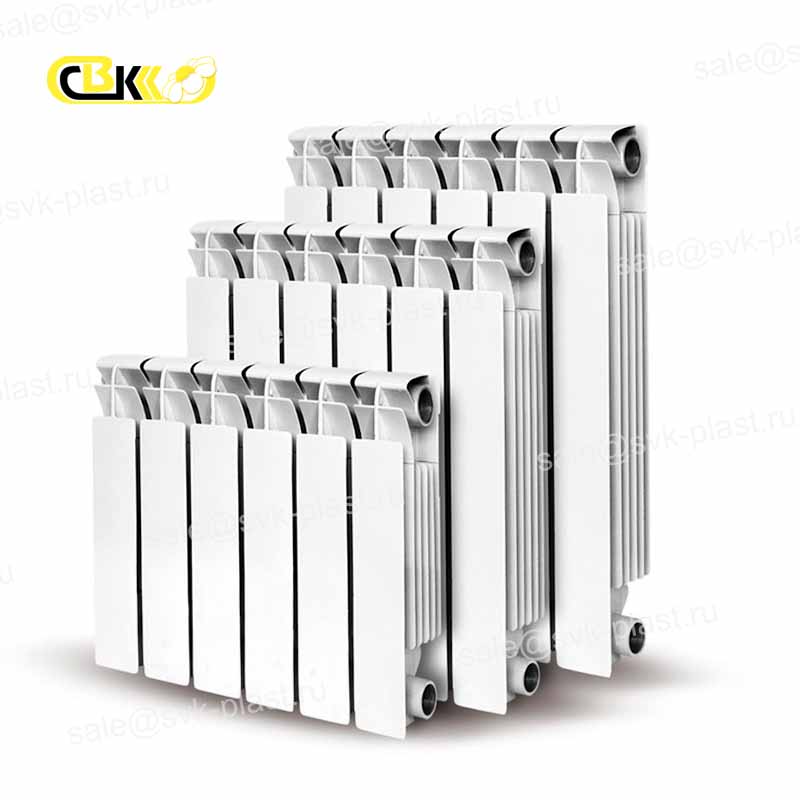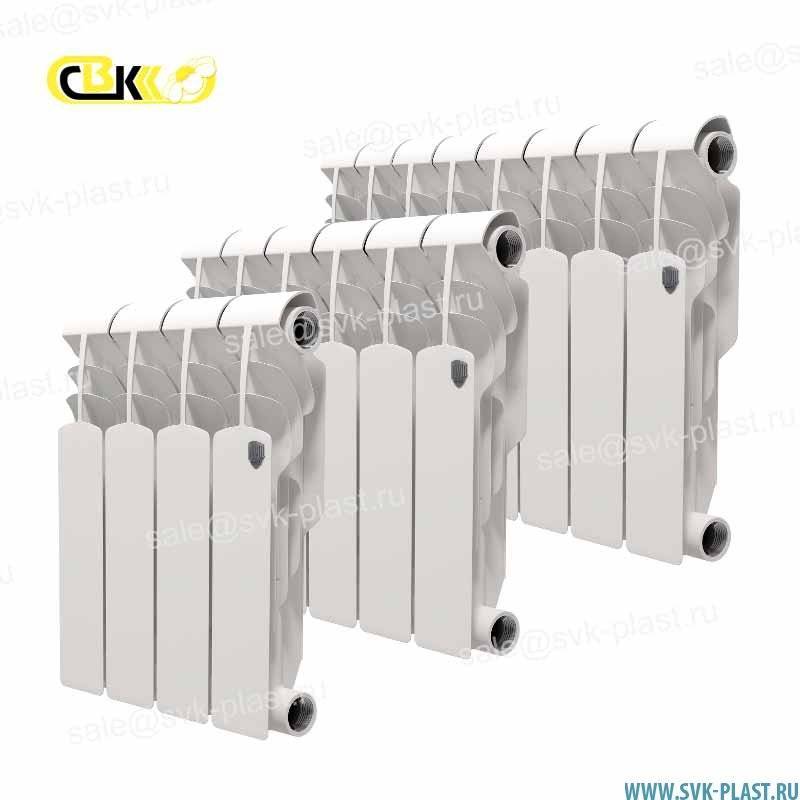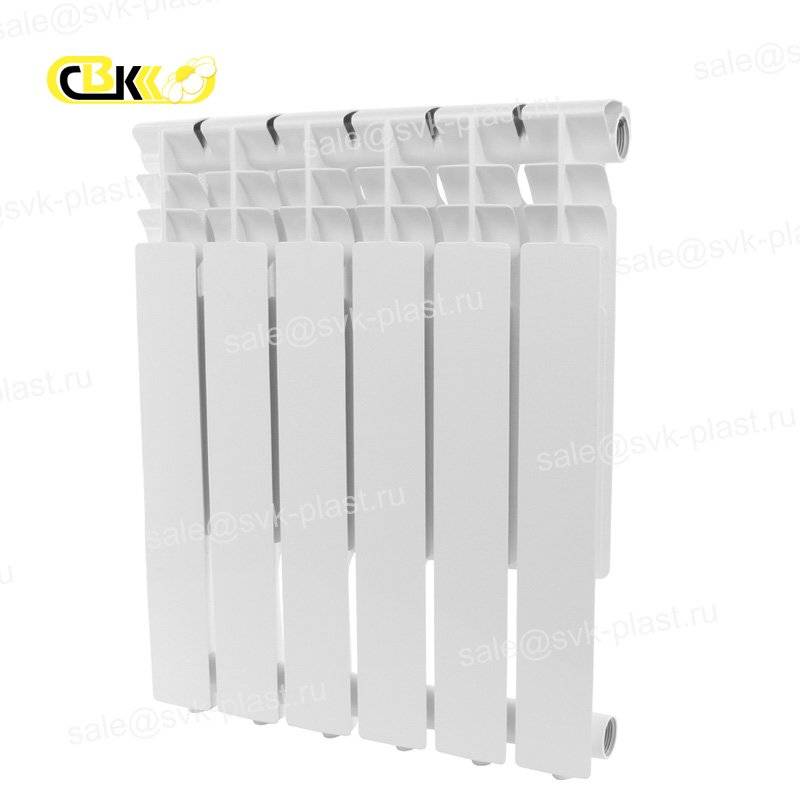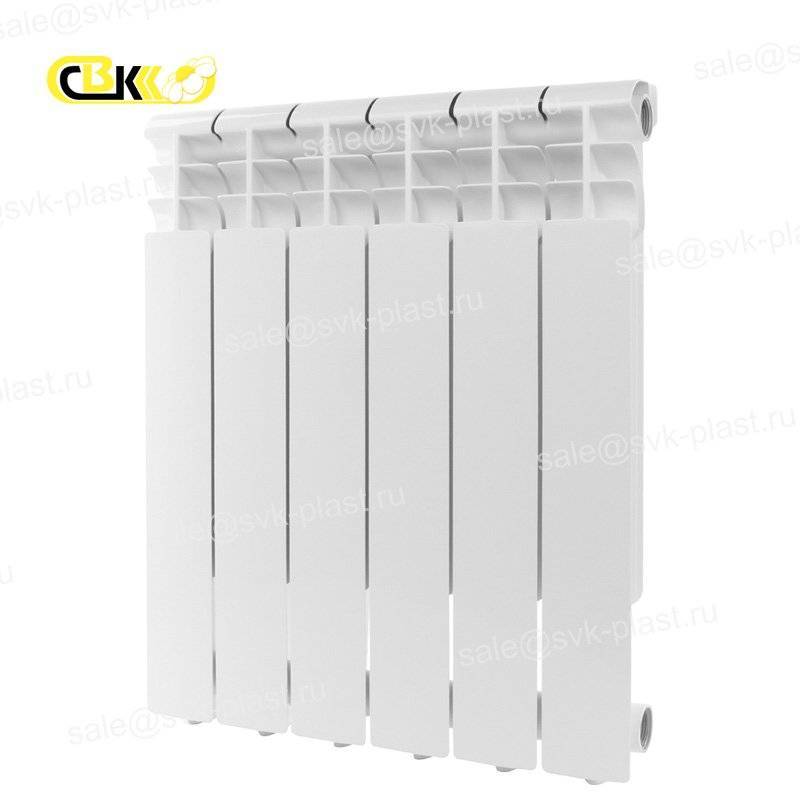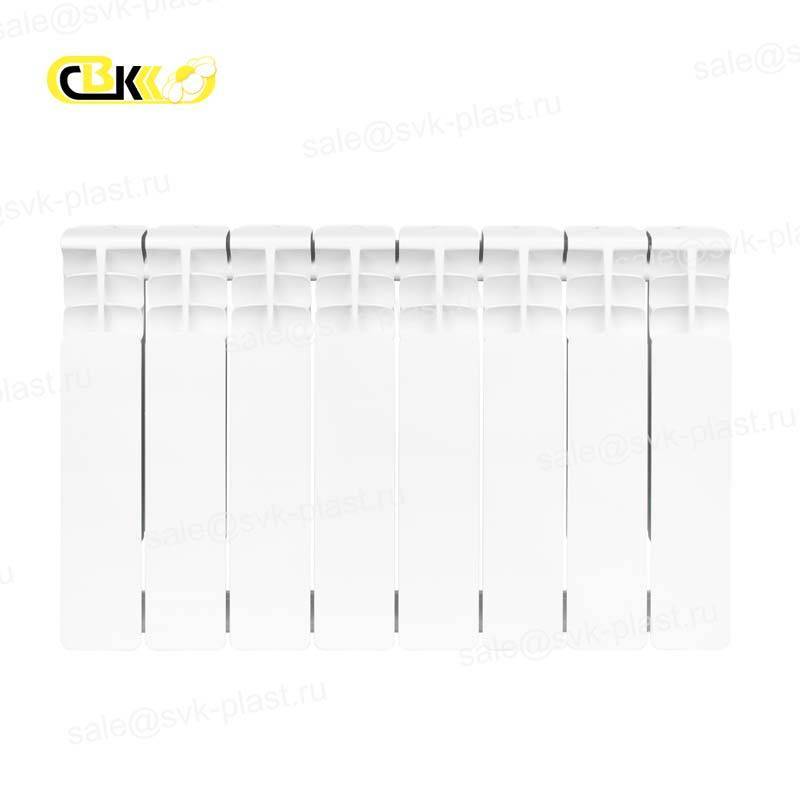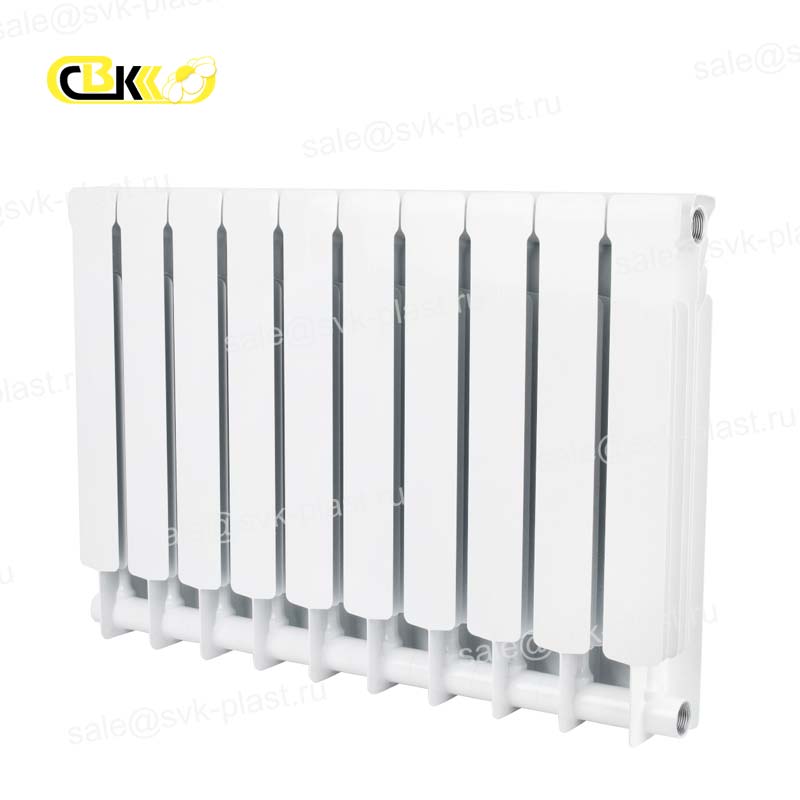Aluminum
Aluminum radiators are a real hit of recent years! Many apartment owners and business owners prefer them to outdated cast iron ones All because aluminum radiators are much lighter, easy to install and at the same time perfectly conduct heat And yet, despite the mass of obvious advantages, these products are available to everyone Aluminum radiators, the price of which is significantly lower than similar ones made of steel or cast iron, You can always buy in " SVK-Plast» Study the catalog and order!
RADENA h 350
| Vendor code | Name |
|---|---|
| 008010104 | Radena aluminum radiator 350 4 sections |
| 008010105 | Radena aluminum radiator 350 5 sections |
| 008010106 | Radena aluminum radiator 350 6 sections |
| 008010107 | Radena aluminum radiator 350 7 sections |
| 008010108 | Radena aluminum radiator 350 8 sections |
| 008010109 | Radena aluminum radiator 350 9 sections |
| 008010110 | Radena aluminum radiator 350 10 sections |
| 008010111 | Radena aluminum radiator 350 11 sections |
| 008010112 | Radena aluminum radiator 350 12 sections |
RADENA h 500
| Vendor code | Name |
|---|---|
| 008010204 | Radena aluminum radiator 500/80 4 sections |
| 008010205 | Radena aluminum radiator 500/80 5 sections |
| 008010206 | Radena aluminum radiator 500/80 6 sections |
| 008010207 | Radena aluminum radiator 500/80 7 sections |
| 008010208 | Radena aluminum radiator 500/80 8 sections |
| 008010209 | Radena aluminum radiator 500/80 9 sections |
| 008010210 | Radena aluminum radiator 500/80 10 sections |
| 008010211 | Radena aluminum radiator 500/80 11 sections |
| 008010212 | Radena aluminum radiator 500/80 12 sections |
| 008010224 | Radena aluminum radiator 500/100 4 sections |
| 008010225 | Radena aluminum radiator 500/100 5 sections |
| 008010226 | Radena aluminum radiator 500/100 6 sections |
| 008010227 | Radena aluminum radiator 500/100 7 sections |
| 008010228 | Radena aluminum radiator 500/100 8 sections |
| 008010229 | Radena aluminum radiator 500/100 9 sections |
| 008010230 | Radena aluminum radiator 500/100 10 sections |
| 008010231 | Radena aluminum radiator 500/100 11 sections |
| 008010232 | Radena aluminum radiator 500/100 12 sections |
Evolution
ROYAL TERMO Indigo
| Vendor code | Name |
|---|---|
| НС-1054826 | Aluminum radiator ROYAL THERMO Indigo 500x100 4 sections |
| НС-1054824 | Aluminum radiator ROYAL THERMO Indigo 500x100 6 sections |
| НС-1054827 | Aluminum radiator ROYAL THERMO Indigo 500x100 8 sections |
| НС-1054828 | Aluminum radiator ROYAL THERMO Indigo 500x100 10 sections |
| НС-1054829 | Aluminum radiator ROYAL THERMO Indigo 500x100 12 sections |
Rommer Optima 500AL
| Vendor code | Name |
|---|---|
| OP50004 | Aluminum radiator Rommer Optima500 4 sections |
| OP50006 | Aluminum radiator Rommer Optima500 6 sections |
| OP50008 | Aluminum radiator Rommer Optima500 8 sections |
| OP50010 | Aluminum radiator Rommer Optima500 10 sections |
| OP50012 | Aluminum radiator Rommer Optima500 12 sections |
Rommer Profi AL
| Vendor code | Name |
|---|---|
| AL350-80-80-4 | Aluminum radiator Rommer Profi 350 4 sections |
| AL-350-80-80-6 | Aluminum radiator Rommer Profi 350 6 sections |
| AL-350-80-80-8 | Aluminum radiator Rommer Profi 350 8 sections |
| AL-350-80-80-10 | Aluminum radiator Rommer Profi 350 10 sections |
| AL-350-80-80-12 | Aluminum radiator Rommer Profi 350 12 sections |
| AL500-80-100-4 | Aluminum radiator Rommer Profi 500 4 sections |
| AL-500-80-100-6 | Aluminum radiator Rommer Profi 500 6 sections |
| AL-500-80-100-8 | Aluminum radiator Rommer Profi 500 8 sections |
| AL-500-80-100-10 | Aluminum radiator Rommer Profi 500 10 sections |
| AL-500-80-100-12 | Aluminum radiator Rommer Profi 500 12 sections |
STOUT Alum 350
| Vendor code | Name |
|---|---|
| SRA-0110-035004 | Aluminum radiator Stout 350 4 sections |
| SRA-0110-035006 | Aluminum radiator Stout 350 6 sections |
| SRA-0110-035008 | Aluminum radiator Stout 350 8 sections |
| SRA-0110-035010 | Aluminum radiator Stout 350 10 sections |
| SRA-0110-035012 | Aluminum radiator Stout 350 12 sections |
| SRA-0110-035014 | Aluminum radiator Stout 350 14 sections |
STOUT Alum 500
| Vendor code | Name |
|---|---|
| SRA-0110-050004 | Aluminum radiator Stout 500 4 sections |
| SRA-0110-050008 | Aluminum radiator Stout 500 8 sections |
| SRA-0110-050010 | Aluminum radiator Stout 500 10 sections |
| SRA-0110-050012 | Aluminum radiator Stout 500 12 sections |
| SRA-0110-050014 | Aluminum radiator Stout 500 14 sections |
Aluminum radiators: types, features and technical characteristics
Aluminum radiators are one of the most popular types of heat exchange equipment They are increasingly preferred by owners of private homes today The latest technologies and high-quality materials are used in the production of these heating devices Aluminum radiators produced by different manufacturers differ not only in appearance, but also in their technical characteristics They are very light, compact, have excellent performance and are able to fit harmoniously into any interior
Despite the ever-increasing popularity, it should be borne in mind that aluminum radiators are not very versatile To choose the right batteries, taking into account their design and operating conditions, you should study the types of these devices, the specifics of their internal structure and consider the main models produced by manufacturers
What should I pay attention to when choosing?
Commercials always emphasize how reliable and durable the equipment on display is However, experts unanimously warn against installing aluminum batteries in the case of a centralized heating system The fact is that its functioning is unstable – in such a system, hydraulic shocks and sudden pressure drops with a high amplitude often occur Such failures can damage the internal channels of the radiator and cause damage to its connections Also, do not forget that the coolant used in a centralized system may be impure or low-quality, with the addition of acids or alkalis that can damage aluminum surfaces From this we can conclude that aluminum batteries are designed to be connected to Autonomous heating systems used in the private residential sector – that is, where residents have access to tools for monitoring temperature and pressure indicators, and checking the quality of the heat carrier
Currently, fake radiators are often sold in markets and even in individual non-chain stores In the production of counterfeit products, as a rule, the logo of a popular brand is borrowed-in full, or in a slightly modified form, but the quality of counterfeit equipment is always inferior to the original There is a clear pattern – the better the reputation of the manufacturer, the more often the equipment produced by it is forged
That is why it is worth buying heat exchange equipment only in special stores, where all the products offered have quality certificates When choosing, you must carefully study the technical passport and documentation attached to the radiator, and make sure that the manufacturer provides a warranty period
Types of aluminum radiators and their manufacturing methods
In the manufacture of batteries, the main raw materials are metal alloys, including special silicon additives Not only individual sections, but also entire collectors are made of such alloys Currently, manufacturers use 2 key methods for manufacturing radiators-extrusion and casting
Manufacture of heat sinks by extrusion
In the course of extrusion (from the Latin the word extrusio, which translates as "ejection") heated to a soft metal alloy is forced through a special molding extruder, resulting in a part of the required shape When using this method, it is impossible to produce closed components for the battery, for this reason, separate parts are first created — the front and back, and then they are bonded by thermal pressing
This technique is used in the production of not only single sections, but also collectors from separate blanks, also connected to each other using pressing Collectors are made so that they immediately correspond to the dimensions of the future radiator, therefore, during installation or operation, it will be impossible to make the battery shorter or longer
This technological solution is used in the manufacture of batteries of foreign manufacturers "Swing" and "Olimp", as well as the Russian company " PC-500» The performance of extrusion radiators is significantly worse than that of other types of batteries, since they have a small surface area, and this reduces the level of their heat transfer The most problematic place for extrusion radiators is considered to be pressing seams, since they often do not cope with high pressure or rust due to the negative impact of the coolant Another obvious disadvantage of batteries produced by extrusion is the lack of anti-corrosion qualities The problem is that they are usually made from recyclable materials-aluminum after recycling, so the raw material may have foreign inclusions that enhance the oxidation reaction in the metal However this does not always happen Some brands, including the company "ROVALL", produce batteries that are 98% made of high-purity aluminum, which significantly reduces the likelihood of gas formation inside the devices Further processing allows you to reliably protect the internal surfaces from corrosion, reducing the risk of rust formation to zero
Manufacturing of radiators by injection molding
In the injection method for manufacturing batteries, an aluminum alloy with the addition of silicon is used as a raw material, while silicon accounts for no more than 12% of the composition This amount is enough to make the metal more durable, without reducing the level of its thermal conductivity
The production process is divided into the following stages:
- The mold for casting the radiator section includes 2 parts, which are connected to each other under pressure in the foundry before pouring the molten metal
- The molten metal is guided through the appropriate channels by the plunger to the final shape
- The melt fills each channel of the mold, and, cooling in it, the crystallization process takes place
- The form is opened, and the blank is not removed until it cools completely
- Castings are removed from the mold and subjected to primary processing-cutting off the excess
- With the help of a welding machine, the neck is attached to the workpieces
- Sections are subjected to leak testing of connections, which is performed in a specialized container under high pressure
- All internal and external surfaces of radiator sections are etched with anticorrosive compounds
- After anti-corrosion treatment, the products are cooled and dried
- Sections are directed to the painting with the use of polymer-epoxy powder
- The last stage is the Assembly of sections into batteries, which are then tested for strength and tightness of the connections
Of course, the production process is considered here in the most General terms, since companies that produce radiators can slightly change the technology of their production Foreign companies, especially in the European Union, prefer to manufacture batteries by casting, since the finished products in this case have an increased level of safety and serve much longer
Some manufacturers, for example, the Italian-based company "ROVALL", use a combined technological solution in the production of batteries, in which 2-3 block sections are simultaneously cast, then connected to the collector by electrochemical welding Further, the blocks, which include several sections, are fastened with nipples with silicone seals, so that in the future it will be possible to change the dimensions of the structure For example, if one of the battery packs is damaged, you can do without completely replacing the radiator – it is enough to dismantle the defective element and install a new one in its place Some companies design and produce two-channel sections for batteries In particular, such radiators can be found in the catalog of the company " Faral Trio» They are characterized not only by their ability to withstand high baric loads, but also by an excellent level of heat transfer — about 210 W from each section In the manufacture of such equipment, a specialized alloy is used, a patented method of casting blanks and milling channels with knives with a cross section in the shape of a circle
It is also worth mentioning the finning of batteries, since the number of heat exchange fins directly affects their level of heat transfer In particular, the manufacturer "Alterplast" produces radiators "Radena", equipped with sections that have 6 ribs Such a structure of the radiator facilitates heat transfer enhancement is achieved due to increased heat transfer fins, and also because of the emergence of convective hot air stream In batteries with multiple fins, convection dominates direct radiation, and a directed stream of heated air forms an air-heat curtain for Windows, preventing frosty street air from entering the room
Anodized radiators
Anodized radiators, as mentioned earlier, are made of a metal alloy, in which 98% of the composition is refined aluminum Such equipment is subjected to anodic oxidation not only inside, but also outside This type of treatment is also called anodizing or electrochemical oxidation Anodizing involves the use of various technologies to obtain the thinnest oxide coating that performs a protective or decorative function This procedure is performed in an environment of solid or liquid electrolytes, and at the end of it, metal surfaces become resistant to rust and other destructive factors
Anodic oxidation of batteries is performed in several stages:
- Flushing occurs, during which the batteries are prepared for the main treatment To do this, the entire product or individual battery sections are placed in a container filled with an alkaline solution, which removes all types of dirt from the metal surface, dissolving them
- "Chemical milling" is performed, also called etching At this step, not only the naturally formed oxide coating is removed from the aluminum surface, but also a thin surface layer of metal As a rule, caustic soda-based products are used in the process Heavy metals contained in the alloy are also removed from the aluminum surface To perform anodic oxidation, the battery is immersed in a container filled with electrolyte In this situation, aluminum plays the role of the electrode with a " + "charge, that is, the anode, and the electrolyte-the electrode with a" – " charge, or the cathode This leads to a chemical reaction that results in a protective oxide coating on the surface
- If necessary, adsorption painting is performed, in which the coloring pigment penetrates the pores of the previously formed oxide coating
- The layers are compacted, i.e. the pores are blocked
When connecting the battery components to each other, instead of nipples, external dry couplings are used, so that the internal surface at the joints remains smooth, without local constrictions Such a technical solution avoids the formation of stagnant processes inside the radiators, as a result, low hydraulic resistance is observed during the circulation of the coolant
Anodized products have the highest level of heat transfer, far exceeding the performance of ordinary aluminum batteries, and they also cope with pressure in the range of 50-70 ATM This is the only type of aluminum radiator that is fully suitable for connection to a Central heating system To date, in domestic stores you can find anodized batteries from the company "Aluwork", produced in Italy They come in a variety of colors and sizes, and their only significant drawback is the relative high cost
Tips for choosing and installing
All aluminum batteries, except for anodized, have similar technical characteristics, and the only thing they differ in is the amount of operating pressure
Consider the characteristics that are common to all panels of aluminium:
- Section heat transfer level: 80-212 watts
- The maximum permissible temperature of the coolant is 110°C
- Working pressure: 6-16 atmospheres
- The capacity of the section ranges from 250-450 milliliters
- Section weight: 0.8-1.47 kg
- Estimated service life-25 years (if you follow the rules of operation)
- Manufacturer's warranty period: 10-15 years
The center gap (the distance between the horizontal channels at the top and bottom) is usually 20, 35, or 50 cm However, in stores there are also non-standard batteries in which the center distance reaches 90 or even 200 cm Such radiators can be made to order
In order not to miss the dimensions of the purchased equipment, you should measure the area where you plan to install the radiator in advance In the process, you need to remember that the battery should not be closely adjacent to the window sill if it is mounted under the window, since this requires unhindered convection In other words, nothing should prevent the heated air from rising up, while at the same time frosty street air should not enter the room When installing the battery, experts advise you to observe the following distances:
- The product must be installed 10-12 cm above the floor
- A minimum of 10 cm must remain between the battery and the window sill or niche
- Leave a 3 cm gap between the wall and the battery To reduce heat losses and improve the quality of heating, you should attach a reflective screen made of foamed polyethylene or other material to the wall behind the battery
There are different types of coolant supply to the battery: side, bottom, left, right Having a choice greatly facilitates the connection process and allows you to hide pipes in wall voids or under the floor covering
It should be remembered that you can only bring the heat transfer level to the maximum when using a diagonal connection, when the feed will be located on top, and the reverse circuit will be located at the bottom opposite
The permissible level of pressure
In the technical data sheet attached to the equipment, as a rule, there are 2 pressure indicators — pressure testing (for testing) and working The first type refers to the pressure at which the system was tested. it can be described as the maximum level that a particular model is designed for Sometimes this indicator can reach 30-35 atmospheres or more However, keep in mind that the equipment must not run continuously at the maximum load, or it will fail Therefore, when choosing a radiator, first of all it is necessary to be guided by the operating pressure For aluminum radiators, this indicator ranges from 10-16 atmospheres, so before you go to the store, you should first find out from the management company to what maximum level the pressure in the heating system reaches Still, you should not take the risk of buying aluminum batteries for a home with centralized heating They will be more appropriate in an Autonomous system of a private home, in which the pressure never goes beyond 10 ATM However, regardless of the type of heating system, experts recommend selecting batteries for which the operating pressure specified in the technical data sheet exceeds the design load level, as this will minimize the risk of a breakout In the technical data sheet and other documents attached to heat exchange equipment, manufacturers often use different units of measurement to indicate the pressure level To simplify the selection process, just remember the ratio: 1 bar = 0.1 MPa = 1 ATM
The heat output of aluminum batteries is divided into 2 types: direct heat radiation and convective air heating Each of these complementary types accounts for approximately 50% of the total heat transfer
Radiant heat is radiated from the radiator surfaces, and convective heat, along with hot air flows, comes from the inside, through the top of the device, preventing street air from entering through the window Due to the presence of fins, the convective heat transfer of the battery will be quite high The total heat transfer level of the battery section is indicated in watts and entered in the technical data sheet The size of this characteristic is affected by the dimensions of the section, the volume of the heat carrier passing through it, as well as the number of internal ribs and the surface area where intensive heat transfer occurs Having found out the power of the section, you can easily calculate the total heat output of the aluminum battery as a whole There is a second way: having information about the amount of heat needed to heat a particular room, it is not difficult to calculate how many sections must be in the radiator
It is considered that for high-quality heating of a room, 100 watts of heat energy should be used per 1 m2 However, this formula has a considerable error and using it, you can get both an overabundance and a lack of power The problem is that there are no identical rooms, and in addition to the area, other parameters also matter, including the number of external walls, their geographical orientation, the size of Windows and other glazed surfaces, the presence of a loggia, and much more In order not to make a mistake when calculating the number of sections required for heating a room, you should use a special calculator, which takes into account all possible corrections to the features of the room and the connection scheme of radiators in advance As mentioned earlier, the installation method of batteries strongly affects the level of their heat transfer
Low thermal inertia of radiators contributes to increased heat transfer, creating a comfortable microclimate in a heated room According to this indicator, aluminum batteries are superior to analogues made of other materials-steel, cast iron and bimetal Installing aluminum radiators in a private home can significantly reduce fuel consumption, thereby providing considerable monetary savings
Design design
Aluminum batteries are ergonomically designed, which allows them to fit harmoniously into any interior The color scheme of radiators can be very different Many salons offer the service of drawing images on heating equipment to visually hide its presence in the room, or on the contrary-to decorate the batteries and turn them into the main element of the situation
Manufacturers prefer to produce the same type of radiators, but if necessary, you can find models with an unusual design on sale For example, some companies produce floor radiators, as well as products with a variety of devices, including special fasteners for drying towels (such a radiator can be installed in the kitchen) In addition, there are floor radiators for hallways that allow you to dry shoes
Pros and cons of aluminum radiators
Like any heating equipment, aluminum radiators have not only strengths, but also weaknesses that should be taken into account to prevent breakouts during operation
Consider the main advantages of aluminum batteries:
- Excellent heat transfer, thanks to which the room warms up quickly
- Lightweight, greatly facilitating the installation process Such devices can be easily hung on the fasteners and independently connected to the pipes of the heating system
- A wide choice of sizes makes it possible to install in any place, and thanks to the ergonomic and attractive design, radiators are combined with any interior
- The softness of aluminum prevents serious injuries from accidental impact, so these products can be installed even in the children's room
- Additional connection of the thermostat allows you to adjust the heat output of the equipment, thereby setting a comfortable temperature level in the house and saving on energy consumption
The disadvantages of aluminum radiators include the following:
- They can't handle high pressure and sudden changes in pressure, especially hydraulic shocks
- The specific chemical activity of aluminum can provoke intense gas formation inside the battery, which can damage the seams and joints, or cause the formation of air jams that interfere with the free flow of the coolant
- If mistakes were made during installation, the heat will be unevenly distributed across the battery
It should be clarified that some of the above disadvantages that appear during operation can be eliminated For example, to prevent damage from excessive gas formation, it is enough to put air vents on the batteries
When installing aluminum radiators in a house connected to a centralized heating system, you should choose the anodized version, since they have increased resistance to sudden pressure drops, and the protective coating makes them resistant to the destructive effects of the heat carrier


